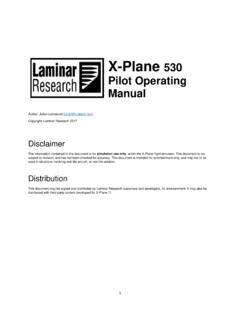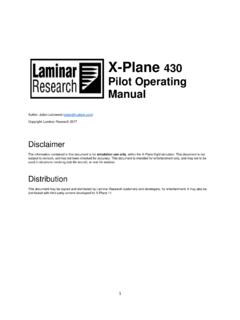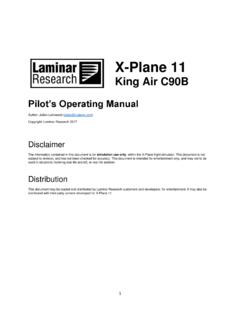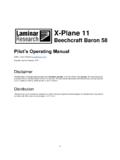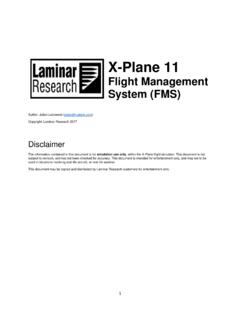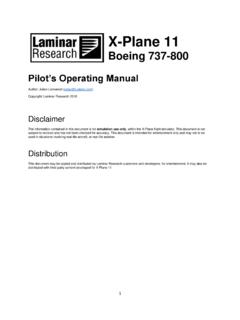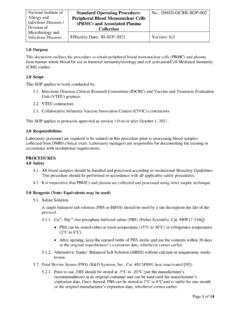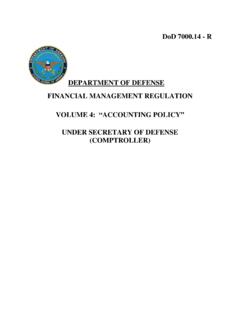Transcription of Baron Pilot Operating Manual - X-Plane 11
1 1 X-Plane 11 Beechcraft Baron 58 Pilot s Operating Manual Author: Julian Lockwood Copyright: Laminar Research 2017 Disclaimer The information contained in this document is for simulation use only, within the X-Plane flight simulator. This document is not subject to revision, and has not been checked for accuracy. This document is intended for entertainment only, and may not to be used in situations involving real-life aircraft, or real-life aviation. Distribution This document may be copied and distributed by Laminar Research customers and developers, for entertainment. It may also be distributed with third-party content developed for X-Plane 11. 2 Contents Background: The Beechcraft Baron 58 Series .. 3 B58 Specifications.
2 4 The X-Plane Baron B58 .. 5 Instrument panel and controls .. 6 Creating Quick Look views .. 7 Operating the controls .. 11 Assigning peripheral devices .. 13 A Tour of the Cockpit .. 16 Pilot s Door Panel .. 16 Pilot s Primary Instruments .. 17 Engine Instrumentation .. 21 Avionics Panel .. 23 Instrument Sub Panel .. 26 Throttle Quadrant and Center Console .. 30 Copilot s Secondary Instruments .. 33 Autopilot Operation .. 34 Flight Planning .. 37 Fuel Calculation .. 38 Taxi Fuel .. 38 Trip Fuel .. 38 Contingency Fuel .. 39 Alternate Destination Fuel .. 39 Final Reserve Fuel .. 39 Additional Fuel .. 39 Discretionary Fuel .. 39 Final Calculated Fuel Load .. 39 Weight & 40 Check Lists .. 45 Operational Speeds .. 53 3 Background: The Beechcraft Baron 58 Series Photo credit: Wikipedia The Beech Aircraft Corporation first introduced the Baron in 1961.
3 Derived from the Travel Air, the Baron incorporated the fuselage of the Bonanza, and the tail section of the Debonair. The aircraft was the Beech corporation s answer to the Piper Aztec (launched in 1960), and the improved Cessna 310 of the same era. Powering the first model, the 55, were two Continental IO-470-L engines, each producing 260 horsepower at 2,625 rpm. Seating options included room for one Pilot , and a four or five, passengers. Early Model 55s had a gross weight of 4,880 to 5,100 lbs. (2,200 to 2,300 kg.). Typical cruise speeds were in the range of 190 knots, at an altitude of 7,000 ft. Two fuel tank options were available 116 US gallons, or 136 US gallons. The Model 55 was manufactured from 1961 to 1982, and by the end of the manufacturing run, this model incorporated improved avionics, some aerodynamic refinements, and an upgraded fuel capacity to 172 US gallons.
4 Four hundred and thirty-three (433) model 55s were built. The Model 56 was introduced in 1967, as a test-bed for the Beech Duke 60 pressurized twin that was under development at the time. The turbo-charged Lycoming TIO-540-E1B4 engines from the Duke were fitted to the Baron , together with structural modifications to accommodate these. The Model 56 was manufactured from 1967 to 1971. Ninety-three (93) aircraft were built. The Model 58 was introduced in 1969 a larger more powerful variant of the Model 55. The new aircraft incorporated club seating, double aft baggage doors, and a gross weight of 5,400 lbs. Two engine options currently applied at the time the Continental IO-520 (285 hp.), or Continental IO-550 (300 hp.). In 1976, a turbo-charged version called the Model 58TC was introduced, and also a pressurized version called the Model 58P.
5 These models were capable of cruising at 200 knots at an altitude of 8,000 feet, and 220 knots at an altitude of 20,000 feet respectively. The Baron 58 was manufactured from 1969 to 2004, the 58TC from 1976 to 1984, the 58P from 1976 to 1985. Currently, the Baron Model G58 remains in production. This is essentially the same as the Model 58, with a Garmin G1000 (glass cockpit) avionics package. New 2016 Model G58s sell for approximately $US million. Approximately 6,700 Baron B58s (of various guises) have been manufactured to date. 4 B58 Specifications Engine: Model ---------------------------------------- - 2 x Continental IO-550-C (piston) Power ---------------------------------------- - 300 horsepower per engine Propeller ---------------------------------------- - 3 blade metal, constant speed Fuel: Capacity ---------------------------------------- - 194 Gallons / 1,164 Lbs.
6 Recommended fuel ---------------------------------------- - 100 Octane Low Lead (100LL) Fuel Burn (average) ---------------------------------------- - 32 Gallons per hour / 120 Liters per hour Weights and Capacities: Max. Takeoff Weight ---------------------------------------- - 5,500 Lb. / 2,495 Kg. Max. Landing Weight ---------------------------------------- - 5,400 Lb. / 2,449 Kg. Basic Empty Weight ---------------------------------------- - 4,030 Lb. / 1,828 Kg. Max. Useful Load ---------------------------------------- - 1,494 Lb. / 678 Kg. Maximum Payload ---------------------------------------- - 1,370 Lb. / 621 Kg. Performance: Max. Cruise Speed ---------------------------------------- - 202 Knots Stall Speed (Clean) ---------------------------------------- - 80 Knots Stall Speed (Landing Configuration) ---------------------------------------- - 74 Knots Best Climb Rate ---------------------------------------- - 1,700 Feet Per Minute Wing Loading ---------------------------------------- - Lb.
7 / Sq. Ft. Power Loading ---------------------------------------- - Lb. / Hp. Service Ceiling ---------------------------------------- - 20,688 Ft. Takeoff Ground Roll ---------------------------------------- - 1,373 Ft. 5 The X-Plane Baron B58 Unlike other flight simulators, X-Plane employs a technique called blade element theory. This technique uses the actual shape of the aircraft (as modeled in the simulator), and breaks down the forces on each part separately. The force of the air acting on each component of the model is individually calculated, and combined, to produce extremely realistic flight. When you fly an airplane in X-Plane , there are no artificial rules in place to govern how the aircraft behaves. Your control inputs move the control surfaces of the aircraft, and these interact with the flow of air around it.
8 As such, you may consider that you are really flying the aircraft. Because of this technique, an aircraft must be modeled with great accuracy in X-Plane , in order that it behave like its real-life counterpart. This means the fuselage, wings and tail surfaces must be the right size and shape, the center of lift and center of gravity must be in the right places, and the engine(s) must develop the right amount of power. In fact, there are a great many properties that must be modeled correctly to achieve a high-fidelity flight model. The Beechcraft Baron B58 in X-Plane has been modeled by our design team with a degree of accuracy that ensures its flight characteristics are very like the real aircraft. However, despite this, some differences will be apparent, because even the smallest factor plays into the ultimate behavior of the aircraft, both in real life, and in X-Plane .
9 The systems modeling of this aircraft involves some compromise too, because of the degree of complexity present in a real aircraft. However, in most cases, the actual Baron B58 procedures could be followed when Operating the X-Plane version. Checklists are presented later in this document (with modifications to suit a simulation platform). It is recommended that X-Plane pilots follow those procedures to extract the maximum capability and enjoyment from this aircraft. 6 Instrument panel and controls The X-Plane Baron B58 features a detailed 3-D cockpit with a great many of the primary controls and systems modeled, including: Flight controls (yoke, rudder pedals, throttles, prop levers, mixture levers), electrical systems, navigation aids, radios, autopilot, instrument, lighting and fuel systems.
10 Elements that are not modeled include cabin environmental systems, and circuit breakers. Hint: To best view some of the switches featured in this aircraft, it is helpful to hide the Pilot and co- Pilot yokes. This can be accomplished by selecting Joystick and Equipment from the Settings menu, and assigning a button, or key, to the following data reference: Operation | Toggle Yoke Visibility Use the assigned button, or key, to toggle the yoke view as required. This will have no effect on the yoke operation. 7 Creating Quick Look views Before discussing the instrument panel and controls for this aircraft, we suggest that the Pilot establish a series of Quick Look views that will be helpful later when interacting with this particular aircraft.
